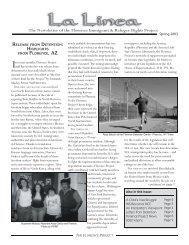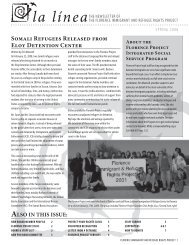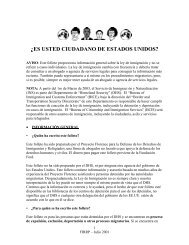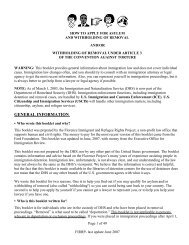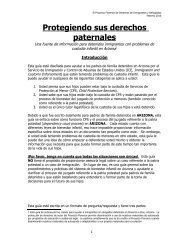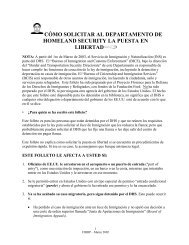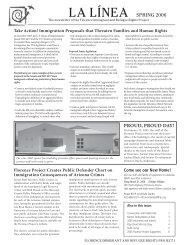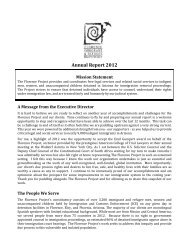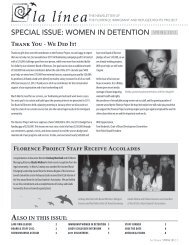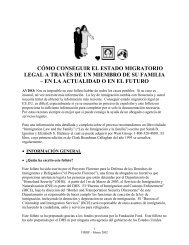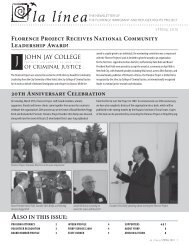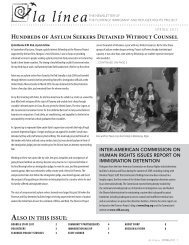quick reference chart and annotations for determining immigration ...
quick reference chart and annotations for determining immigration ...
quick reference chart and annotations for determining immigration ...
You also want an ePaper? Increase the reach of your titles
YUMPU automatically turns print PDFs into web optimized ePapers that Google loves.
Introduction<br />
Note to Immigration Attorneys: Using the Chart. This <strong>chart</strong> was written <strong>for</strong> criminal defense<br />
counsel, not <strong>immigration</strong> counsel. It represents a fairly conservative view of the law, meant to<br />
guide criminal defense counsel away from potentially dangerous options <strong>and</strong> toward safer ones.<br />
Thus <strong>immigration</strong> counsel should not rely on the <strong>chart</strong> in deciding whether to pursue defense<br />
against removal. An offense may be listed as an aggravated felony or other adverse category<br />
here even if there are strong arguments to the contrary that might prevail in <strong>immigration</strong><br />
proceedings. For a more detailed analysis of Ninth Circuit law, see cited sections of Defending<br />
Immigrants in the Ninth Circuit (www.ilrc.org, 2009) <strong>and</strong> other works in Note “Resources.”<br />
The Chart can provide guidance as to the risk of filing an affirmative application <strong>for</strong> a noncitizen<br />
with a criminal record. The Notes are concise <strong>and</strong> basic summaries of several key topics.<br />
1. Using the Chart <strong>and</strong> Notes. The Chart analyzes adverse <strong>immigration</strong> consequences that<br />
flow from conviction of selected Arizona offenses <strong>and</strong> suggests how to avoid the consequences.<br />
Endnote <strong>annotations</strong> discuss each offense in greater detail. The Chart appears organized<br />
numerically by code section.<br />
Several short articles or “Notes” provide more explanation of selected topics. These include<br />
Notes that explain the Chart’s <strong>immigration</strong> categories, such as aggravated felonies <strong>and</strong> crimes<br />
involving moral turpitude, as well as those that discuss certain kinds of offenses, such as<br />
domestic violence or controlled substances.<br />
2. Sending comments about the Chart. Contact us if you disagree with an analysis, see a<br />
relevant new case, want to suggest other offenses to be analyzed or to propose other alternate<br />
“safer” pleas, or want to say how the <strong>chart</strong> works <strong>for</strong> you or how it could be improved. Send<br />
email to AZ<strong>chart</strong>@ilrc.org. This address will not answer legal questions. For consultations,see<br />
in<strong>for</strong>mation about obtaining legal consults on cases “contract services” at www.ilrc.org.<br />
3. Need <strong>for</strong> Individual Analysis. This Chart <strong>and</strong> Notes are a summary of a complex body of<br />
law, to be consulted on-line or printed out <strong>and</strong> carried to courtrooms <strong>and</strong> client meetings <strong>for</strong><br />
<strong>quick</strong> <strong>reference</strong>. However, more thorough individual analysis of a defendant’s <strong>immigration</strong><br />
situation is needed to give competent defense advice. For example, the defense goals <strong>for</strong><br />
representing a permanent resident are different from those <strong>for</strong> an undocumented person, <strong>and</strong><br />
analysis also changes depending upon past convictions <strong>and</strong> what type of <strong>immigration</strong> relief is<br />
potentially available. See Note “Establishing Defense Goals.” The Chart <strong>and</strong> Notes are best<br />
used in conjunction with resource works such as Brady, Defending Immigrants in the Ninth<br />
Circuit (citations to specific sections are included throughout these materials) or Tooby,<br />
Criminal Defense of Immigrants, <strong>and</strong>/or along with consultation with an <strong>immigration</strong> expert.<br />
See Note “Resources.”<br />
Ideally each noncitizen defendant should complete a <strong>for</strong>m such as the one found at Note<br />
“Immigrant Client Questionnaire,” which captures the in<strong>for</strong>mation needed to make an<br />
<strong>immigration</strong> analysis <strong>and</strong> is a diagnostic aid. Some offices print these <strong>for</strong>ms on colored paper, so<br />
ii



